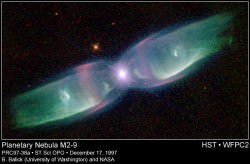Who knows what the future holds for our Sun? Dr. Mark Morris, a professor of astronomy at UCLA sure knows. Professor Morris sat down with us to let us know what we’re in for over the next few billions years.
“Hi, I’m Professor Mark Morris. I’m teaching at UCLA where I also carry out my research. I work on the center of the galaxy and what’s going on there – in this fabulous arena there, and on dying stars – stars that have reached the end of their lifetime and are putting on a display for us as they do so.”
What is the future of our sun?
“Well, there’s every expectation that in about 5 billion more years, that our sun will swell up to become a red giant. And then, as it gets larger and larger, it will eventually become what’s called an asymptotic giant branch star – a star whose radius is just under the distance between the sun and the Earth – one astronomical unit in size. So the Earth will be literally skimming the surface of the red giant sun when it’s an asymptotic giant branch star.”
“A star that big is also cool because they’re cold – red hot versus blue hot or yellow hot like our sun. Because it’s cold, a red giant star at its surface layers can keep all of its elements in the gas phase. So some of the heavier elements – the metals and the silicates – condense out as small dust grains, and when these elements condense out as solids, then radiation pressure from this very luminous giant star pushes the dust grains out. That may seem like a minor issue, but in fact these dust grains carry the gas with them. And so the star literally expels its atmosphere, and goes from a red giant star to a white dwarf, when finally the core of the star is exposed. Now, as it’s doing this, that hot core of the star is still very luminous and lights up through a fluorescent process, this out-flowing envelope, this atmosphere that was once a star, and that’s what produces these beautiful displays that are called planetary nebulae.”
“Now, planetary nebulae can be these beautiful round, spherical objects, or they can be bipolar, which is one of the mysteries that we’re working here is trying to understand why, at some stage, a star suddenly becomes axisymmetric – in other words, is sending out is’s atmosphere in two diametrically opposed directions predominantly, rather than continuing to lose mass spherically.”

“We can’t invoke rotation of the star – that would be one way to get a preferred axis, but stars don’t rotate fast enough. If you take the sun and let it expand to become a red giant, then by the conservation of angular momentum, it literally won’t be spinning at all. It’ll be spinning so slowly that it’ll literally have no effect. So we can’t invoke spin, so there must be something going on deep down inside the star, that when you finally expose some rapidly spinning core, it can have an effect.”
“Or, all of the stars that we see as planetary nebula can have binary companions, that could be massive planets or relatively low mass stars that themselves can impose an angular momentum orientation on the system. This is in fact an idea that I’ve been championing for decades now, and it has some traction. There’s a lot of planetary nebula nuclei, the white dwarves, that seem to have companions near them that are suspect for having been responsible for helping strip the atmosphere of the mass-losing red giant star but also providing a preferred axis along which the ejected matter can flow.”

